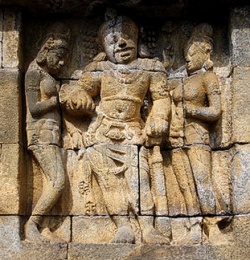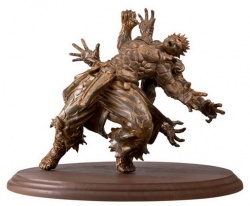Difference between revisions of "Asura"
(Created page with "thumb|250px| Asura (Sanskrit, Pāli: असुर; Tibetan: Lha-ma-yin; Japanese: 阿修羅 Ashura; Korean: 아수라; Chinese: 阿修罗; pinyin:...") |
|||
| Line 1: | Line 1: | ||
[[File:Asura_Dvarapala.jpg|thumb|250px|]] | [[File:Asura_Dvarapala.jpg|thumb|250px|]] | ||
| − | Asura (Sanskrit, Pāli: असुर; Tibetan: Lha-ma-yin; Japanese: 阿修羅 Ashura; Korean: 아수라; Chinese: 阿修罗; pinyin: Āxiūluō, Vietnamese: A tu la) in Buddhism is the name of the lowest ranks of the deities or demigods of the Kāmadhātu. They are described as having three heads with three faces and four to six arms. | + | Asura ([[Sanskrit]], [[Pāli]]: असुर; Tibetan: Lha-ma-yin; Japanese: 阿修羅 Ashura; Korean: 아수라; Chinese: 阿修罗; pinyin: Āxiūluō, Vietnamese: A tu la) in [[Buddhism]] is the name of the lowest ranks of the deities or demigods of the Kāmadhātu. They are described as having three heads with three faces and four to six arms. |
Origins and etymology | Origins and etymology | ||
| − | The Buddhist | + | The Buddhist [[Asuras]] are broadly derived, in general character, from the wicked [[Asuras]] of [[Hinduism]], but have acquired some very distinctive myths which are only found in [[Buddhist texts]]. |
For the etymology of asura, see Aesir-Asura correspondence. | For the etymology of asura, see Aesir-Asura correspondence. | ||
In its Buddhist context, the word is sometimes translated "Titan" (suggesting the wars of the Greek gods and Titans), "demigod", or "antigod". | In its Buddhist context, the word is sometimes translated "Titan" (suggesting the wars of the Greek gods and Titans), "demigod", or "antigod". | ||
| − | Character of the Asuras | + | Character of the [[Asuras]] |
| − | While all the gods of the Kāmadhātu are subject to the passions to some degree, the Asuras above all of them have become addicted to them, especially wrath, pride, boasting, and bellicosity. | + | While all the gods of the Kāmadhātu are subject to the passions to some degree, the [[Asuras]] above all of them have become addicted to them, especially wrath, pride, boasting, and bellicosity. |
| − | Because of their passions, | + | Because of their passions, [[Rebirth]] as an Asura is considered to be one of the four unhappy births (together with [[Rebirth]] as an animal, a preta, or a being in [[Naraka]]). The state of an Asura reflects the [[Mental]] state of a human being obsessed with force and violence, always looking for an excuse to get into a fight, angry with everyone and unable to maintain calm or solve problems peacefully. |
| − | In terms of | + | In terms of [[Power]], [[Asuras]] rank above humans but below most of the other deities. They live in the area at the foot of Mount [[Sumeru]], at least partially in the sea that surrounds it. |
| − | On the popular cosmic picture of the Bhavacakra, the Asuras are sometimes shown as a sixth stage of existence, and sometimes grouped together with the devas. The five-stage version was the original , and the addition of the Asuras as the sixth was done in Tibet on the authority of Je Tsongkhapa. | + | On the popular cosmic picture of the Bhavacakra, the [[Asuras]] are sometimes shown as a sixth stage of existence, and sometimes grouped together with the devas. The five-stage version was the original , and the addition of the [[Asuras]] as the sixth was done in Tibet on the authority of [[Je Tsongkhapa]]. |
[[File:08-ASURAS.jpg|thumb|250px|]] | [[File:08-ASURAS.jpg|thumb|250px|]] | ||
| − | The leaders of the Asuras are called Asurendra (Pāli: Asurinda) "Asura- | + | The leaders of the [[Asuras]] are called Asurendra ([[Pāli]]: Asurinda) "Asura-[[Lord]]". There are several of these, as the [[Asuras]] are broken into different tribes or factions. Among them are the bow-wielding Dānaveghasa [[Asuras]], and the terrible-faced Kālakañjakas. The principal leaders are [[Vemacitrin]] ([[Pāli]]: Vepacitti), Rāhu (also called Veroca or Verocana), and Pahārāda. |
| − | Myths of the Asuras | + | Myths of the [[Asuras]] |
| − | The Asuras formerly lived in the Trāyastriṃśa | + | The [[Asuras]] formerly lived in the [[Trāyastriṃśa]] [[World]], on the peak of Mount [[Sumeru]], with the other gods of that [[World]]. When Śakra became the ruler of that [[World]], the [[Asuras]] celebrated by drinking a lot of Gandapāna wine, a liquor so strong that Śakra forbade the other gods to drink it. Weakened by their drunkenness, the [[Asuras]] could not resist when Śakra had the whole lot of them thrown over the edge of [[Trāyastriṃśa]] into what would become the Asura-[[World]] at the base of [[Sumeru]]. A tree grows there called Cittapātali; when the [[Asuras]] saw it blossom, they saw that it was different from the Pāricchattaka ([[Sanskrit]]: Pāriyātra) tree which had grown in their old home, and they knew that they were dispossessed. |
| − | They now meditated on | + | They now meditated on [[War]]. In armor and [[Weapons]], they climbed up the steep slopes of [[Sumeru]] "like ants". Śakra set out to meet them, but was forced to [[Retreat]] because of their numbers. Passing through the forest where the garuḍas live on his flying chariot, Śakra saw that his passage was destroying the nests of the garuḍas and ordered his charioteer Mātali to turn back. When the pursuing [[Asuras]] saw Śakra turn about, they felt certain that he must be coming back with an even larger army, and they fled, ceding all the ground they had gained. |
| − | Despite their many wars, there was eventually a partial concord between the Trāyastriṃśa gods and the Asuras. This came about because Śakra fell in | + | Despite their many wars, there was eventually a partial concord between the [[Trāyastriṃśa]] gods and the [[Asuras]]. This came about because Śakra fell in [[Love]] with Sujā, daughter of the Asura chief [[Vemacitrin]]. [[Vemacitrin]] had given Sujā the right to choose her own husband at an assembly of the [[Asuras]], and she chose Śakra, who had attended disguised as an aged Asura. [[Vemacitrin]] thus became Śakra's father-in-law. |
{{W}} | {{W}} | ||
[[Category:Buddhist Terms]] | [[Category:Buddhist Terms]] | ||
[[Category:Asuras]] | [[Category:Asuras]] | ||
| + | [[Category:Pali terminology]] | ||
Revision as of 21:55, 9 April 2013
Asura (Sanskrit, Pāli: असुर; Tibetan: Lha-ma-yin; Japanese: 阿修羅 Ashura; Korean: 아수라; Chinese: 阿修罗; pinyin: Āxiūluō, Vietnamese: A tu la) in Buddhism is the name of the lowest ranks of the deities or demigods of the Kāmadhātu. They are described as having three heads with three faces and four to six arms.
Origins and etymology
The Buddhist Asuras are broadly derived, in general character, from the wicked Asuras of Hinduism, but have acquired some very distinctive myths which are only found in Buddhist texts.
For the etymology of asura, see Aesir-Asura correspondence.
In its Buddhist context, the word is sometimes translated "Titan" (suggesting the wars of the Greek gods and Titans), "demigod", or "antigod". Character of the Asuras
While all the gods of the Kāmadhātu are subject to the passions to some degree, the Asuras above all of them have become addicted to them, especially wrath, pride, boasting, and bellicosity.
Because of their passions, Rebirth as an Asura is considered to be one of the four unhappy births (together with Rebirth as an animal, a preta, or a being in Naraka). The state of an Asura reflects the Mental state of a human being obsessed with force and violence, always looking for an excuse to get into a fight, angry with everyone and unable to maintain calm or solve problems peacefully.
In terms of Power, Asuras rank above humans but below most of the other deities. They live in the area at the foot of Mount Sumeru, at least partially in the sea that surrounds it.
On the popular cosmic picture of the Bhavacakra, the Asuras are sometimes shown as a sixth stage of existence, and sometimes grouped together with the devas. The five-stage version was the original , and the addition of the Asuras as the sixth was done in Tibet on the authority of Je Tsongkhapa.
The leaders of the Asuras are called Asurendra (Pāli: Asurinda) "Asura-Lord". There are several of these, as the Asuras are broken into different tribes or factions. Among them are the bow-wielding Dānaveghasa Asuras, and the terrible-faced Kālakañjakas. The principal leaders are Vemacitrin (Pāli: Vepacitti), Rāhu (also called Veroca or Verocana), and Pahārāda. Myths of the Asuras
The Asuras formerly lived in the Trāyastriṃśa World, on the peak of Mount Sumeru, with the other gods of that World. When Śakra became the ruler of that World, the Asuras celebrated by drinking a lot of Gandapāna wine, a liquor so strong that Śakra forbade the other gods to drink it. Weakened by their drunkenness, the Asuras could not resist when Śakra had the whole lot of them thrown over the edge of Trāyastriṃśa into what would become the Asura-World at the base of Sumeru. A tree grows there called Cittapātali; when the Asuras saw it blossom, they saw that it was different from the Pāricchattaka (Sanskrit: Pāriyātra) tree which had grown in their old home, and they knew that they were dispossessed.
They now meditated on War. In armor and Weapons, they climbed up the steep slopes of Sumeru "like ants". Śakra set out to meet them, but was forced to Retreat because of their numbers. Passing through the forest where the garuḍas live on his flying chariot, Śakra saw that his passage was destroying the nests of the garuḍas and ordered his charioteer Mātali to turn back. When the pursuing Asuras saw Śakra turn about, they felt certain that he must be coming back with an even larger army, and they fled, ceding all the ground they had gained.
Despite their many wars, there was eventually a partial concord between the Trāyastriṃśa gods and the Asuras. This came about because Śakra fell in Love with Sujā, daughter of the Asura chief Vemacitrin. Vemacitrin had given Sujā the right to choose her own husband at an assembly of the Asuras, and she chose Śakra, who had attended disguised as an aged Asura. Vemacitrin thus became Śakra's father-in-law.

